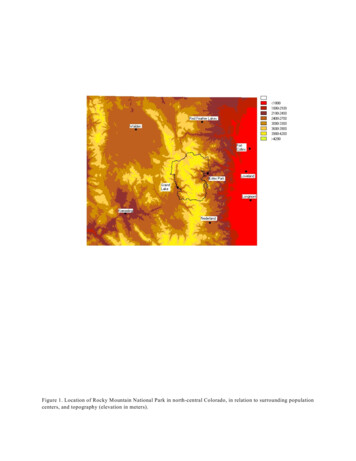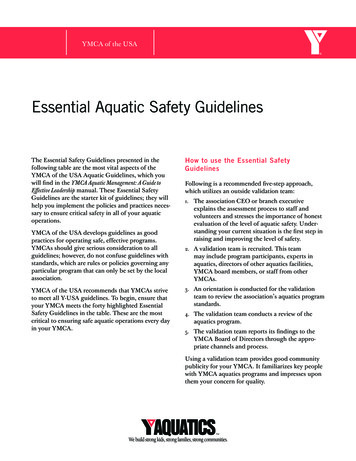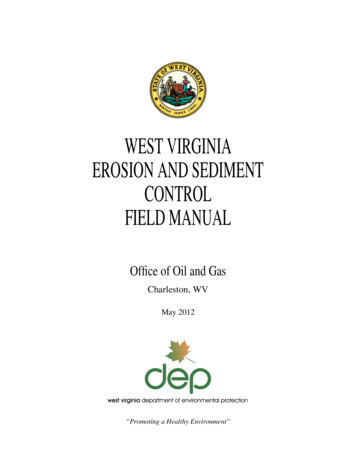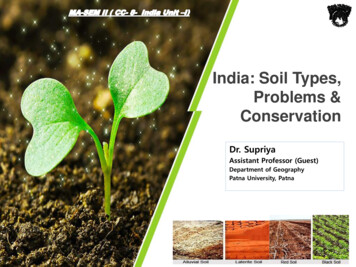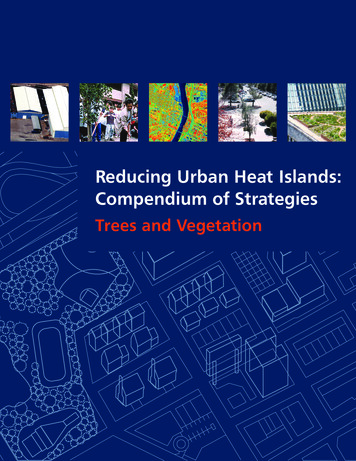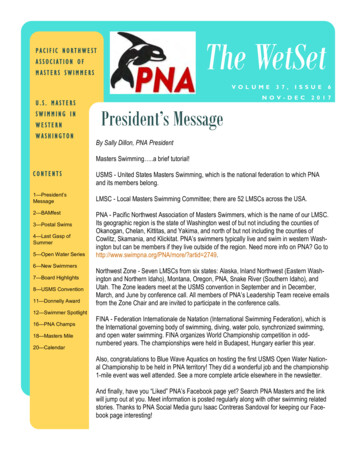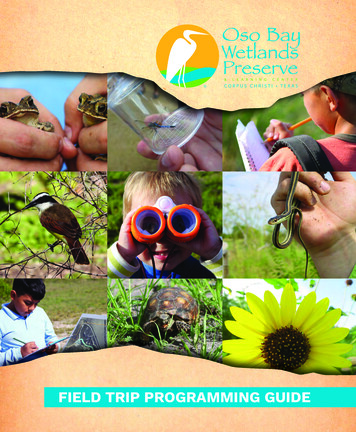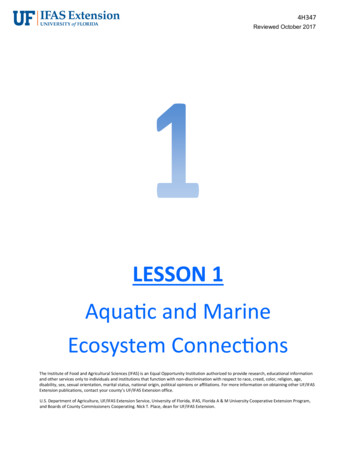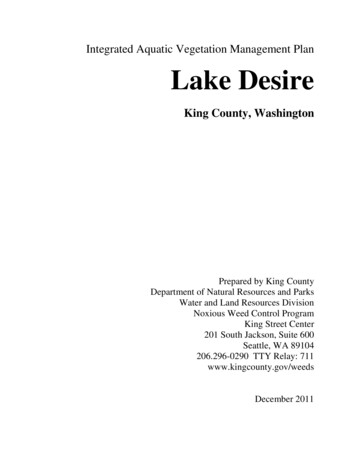
Transcription
Integrated Aquatic Vegetation Management PlanLake DesireKing County, WashingtonPrepared by King CountyDepartment of Natural Resources and ParksWater and Land Resources DivisionNoxious Weed Control ProgramKing Street Center201 South Jackson, Suite 600Seattle, WA 89104206.296-0290 TTY Relay: 711www.kingcounty.gov/weedsDecember 2011
King County ExecutiveDow ConstantineDirector of Department of Natural Resources and ParksChristie TrueDivision Manager of Water and Land Resources DivisionMark IsaacsonWater and Land Resources Division StaffSally AbellaBeth leDouxKatie MessickBen PetersonAnn StevensLake Desire Community Steering CommitteeSally AbellaBetsy LocatelliRoger DannemanJim LocatelliJan FalkenhagenKatie MessickRobert GillettBen PetersonSuzy GillettMelody SiegerJim JamesonTony SiegerLynn JamesonCraig WallaceBeth leDouxii
AcknowledgementThe King County Noxious Weed Control Program wish to thank the members of the Steering Committeefor the Lake Desire Integrated Aquatic Vegetation Management Plan. Members include Sally Abella,Roger Danneman, Jan Falkenhagen, Robert Gillett, Suzy Gillett, Jim Jameson, Lynn Jameson, BethleDoux, Betsy Locatelli, Jim Locatelli, Katie Messick, Ben Peterson, Melody Sieger, Tony Sieger, andCraig Wallace.King County staff were instrumental in developing the IAVMP. Key staff included Ben Peterson andKatie Messick of the Noxious Weed Control Program, as well as Sally Abella and Beth leDoux of theKing County Water and Land Resources Science section. Additional King County Noxious weed controlprogram staff that have helped with this plan include Steve Burke, Ann Stevens, and Edward McFarlin.Thank you to Heather Smith of the Lake Desire Community Club for the many announcements regardingthe IAVMP process in the Lake Desire News and for allowing use of the Lake Desire Clubhouse formeetings. Thank you to Tammie Cooke for providing the list of bird sightings at the lake and to TonySieger for information about the history of the Lake Desire community. Thank you to Jan Falkenhagenfor organizing the gathering of signatures on the Letter of Support and to Betsy Locatelli and JimLocatelli for help editing this document.Washington Department of Ecology staff provided invaluable technical guidance during development ofthe IAVMP. Thank you to Melanie Tyler and Cathy Hamel of the Aquatic Weeds Management Fund fortheir expeditious and through response to our questions.Finally, special thanks to the Lake Desire community. Their enthusiasm and commitment to improvingthe recreational opportunities, ecological integrity and aesthetic beauty of Lake Desire will be the ultimatedriving force of this plan.iii
ContentsEXECUTIVE SUMMARY . 1SECTION 2 - PROBLEM STATEMENT . 3SECTION 3 - MANAGEMENT GOALS . 6SECTION 4 - PUBLIC AND COMMUNITY INVOLVEMENT. 7COMMUNITY COMMITMENT .7STEERING COMMITTEE, OUTREACH, AND EDUCATION PROCESS .7SECTION 5 - WATERBODY AND WATERSHED CHARACTERISTICS . 10WATERSHED CHARACTERISTICS .10WATERBODY CHARACTERISTICS.17BENEFICIAL AND RECREATIONAL USES .18WATER QUALITY .18FISH AND WILDLIFE COMMUNITIES .20CHARACTERIZATION OF AQUATIC PLANTS IN LAKE DESIRE .22NOXIOUS WEEDS AT LAKE DESIRE .25SECTION 6 - MANAGEMENT ALTERNATIVES . 30REED SWEETGRASS (GLYCERIA MAXIMA) .33PURPLE LOOSESTRIFE (LYTHRUM SALICARIA) .33FRAGRANT WATER LILY (NYMPHAEA ODORATA).35EURASIAN WATERMILFOIL (MYRIOPHYLLUM SPICATUM).37SECTION 7 – INTEGRATED TREATMENT PLAN . 40PERMITS .40PURPLE LOOSESTRIFE (LYTHRUM SALICARIA). 40FRAGRANT WATER LILY (NYMPHAEA ODORATA) . 42EURASIAN WATERMILFOIL (MYRIOPHYLLUM SPICATUM).43PLAN ELEMENTS, COSTS, AND FUNDING . 45COSTS OF THE PLAN .45SOURCES OF FUNDING .47SECTION 9 – MONITORING, EVALUATION, AND IMPLEMENTATION . 49MONITORING .49EVALUATION OF THE PLAN .49IMPLEMENTATION .49REFERENCES. 51iiLake Desire IAVMPDecember 2011
List of AppendicesAppendix 1: Meeting Notes, Attendance, public notices, and signatures of supportAppendix 2: Control Method OptionsAppendix 3: Table of Toxicity of Aquatic HerbicidesAppendix 4: Aquatic Herbicide Products LabelsList of Figures and TablesFigure 1a. Lake Desire Regional Map . 10Figure 1b. Lake Desire Vicinity Map . 12Figure 2. Soil Map of Lake Desire Watershed . 14Figure 3. Lake Desire Watershed Map . 15Figure 4. Lake Desire Bathymetirc Map. . 17Figure 5. Aquatic Plants at Lake Desire. . 23Figure 6. Aquatic Noxious Weeds at Lake Desire 2011. 26Table 1 - Soil type . 13Table 2. Average Values for Selected Trophic Parameters at Lake Desire . 20Table 3 -Lake Desire Bird List . 21Table 4. Mammals, Reptiles and Amphibians seen in the Lake Desire area . 22Toc310517153Table 5. Aquatic Plants found in Lake Desire 1995-2011. 24Table 6. Summary of Management Alternatives . 31Table 7 -Lake Desire IAVMP Budget. 46Table 8a - Matching funds for total 6-year project . 48Table 8b - Matching funds for Year 1-3 of project . 48Table 8c - Matching funds for Year 4-6 of project . 48iiiLake Desire IAVMPDecember 2011
Executive SummaryLake Desire is a small 72 acre lake located east of Renton in unincorporated King County, Washington.The lake is contained within the Peterson Creek subbasin of the Cedar River Watershed and is part of theWater Resource Inventory Area (WRIA) 8. King County owns 11% of the shoreline and the remaining89% is divided up among 125 private parcels. About 70% of the shoreline is moderately developedresidential and about 30% is undeveloped. The lake has public access, including a public boat rampoperated by Washington Department of Fish and Wildlife and a King County park, and is used forboating, fishing, swimming, wildlife viewing, and ecosystem processes.Lake Desire contains two Class B noxious weed species (purple loosestrife (Lythrum salicaria) andEurasian watermilfoil (Myriophullum spicatum)), one Class A noxious weed species (reed sweetgrass(Glyceria maxima)), and two Class C noxious weeds (fragrant water lily (Nymphaea odorata) and yellowflag iris (Iris pseudacorus)). To date, these infestations have been inadequately addressed at Lake Desire,making the lake a potential source of noxious weed infestations for many nearby lakes. At nearby SpringLake (0.5 mile east of Lake Desire) the community has been working hard to reduce their purpleloosestrife, fragrant water lily, yellow flag iris and Eurasian watermilfoil infestations. At Shady Lake (0.5mile to the south of Lake Desire) local community efforts have been undertaken to control Eurasianwatermilfoil. The close proximity of these lakes means that plants from Lake Desire can easily re-infestSpring and Shady Lakes by vectors such as: wind, animal, human, boat, and boat trailer movement.Eurasian watermilfoil, purple loosestrife, and fragrant water lily can greatly hinder recreational activities,and decrease habitat and water quality at Lake Desire. The outflow from Lake Desire flows south into theCedar River by way of Peterson Creek and through the Peterson Lake Natural Area, both free of purpleloosestrife.Members of the Lake Desire community along with the King County Noxious Weed Control programrealized the importance of controlling these noxious weeds at Lake Desire to prevent further spread andameliorate the damage that has already been done. As a group they decided to apply for an AquaticWeeds Management Fund grant through the Washington Department of Ecology (Ecology). If awarded,grant money, along with matching hours from King County employees and Lake Desire volunteers, willfund initial eradication efforts and several years of follow-up survey and control. Since eradication isvery difficult to achieve and re-introduction is likely, the community is prepared for the long term effortthat will be required.This Integrated Aquatic Vegetation Management Plan (IAVMP) is a planning document developed toensure that the applicant and community have considered the best available information about thewaterbody and watershed prior initiating control efforts. Members of King County staff and the LakeDesire community worked in partnership to develop this IAVMP for Lake Desire. To address the task ofgenerating community appreciation of and action towards this important ecological, aesthetic andrecreational issue, a core group of residents, along with several King County Staff, formed an IAVMPSteering Committee. The Committee was able to educate the community about the problem, inspire tocontribute feedback about different treatment options, and gather over 125 signatures and a commitmentof over 800 annual volunteer hours towards the project.1Lake Desire IAVMPDecember 2011
In development of the IAVMP control goals were prioritized, focusing on the problems that could beachieved based on funding and other resource limitations. While yellow flag iris is prevalent at the lake,the plant is well established and its control is very resource intensive. Iris is therefore not a target of thismanagement plan. Also, since its discovery and initial treatment, reed sweetgrass appears to have beeneradicated where found at the Lake. The community ultimately agreed on an IAVMP plan whichincorporates and integrated treatment strategy to address three target plants: purple loosestrife, fragrantwater lily, and Eurasian watermilfoil. Control activities targeting these plants will combine an initialtreatment of aquatic herbicide followed by manual control methods. These control activities will be doneby a combination of hired contractors, Lake Desire community volunteers, and King County staff.This IAVMP presents an overview of the aquatic weed problems, details about the community planningprocess, watershed and lake characteristics, a review of suitable control options, a management plan,budget and funding plans, and an implementation plan. There is also a large Appendix section thatcontains background and supporting documents.2Lake Desire IAVMPDecember 2011
Section 2 - Problem StatementLake Desire is a small 72 acre lake located east of Renton in unincorporated King County. The lake iscontained within the Peterson Creek subbasin of the Cedar River Watershed and is part of the WaterResource Inventory Area (WRIA) 8. King County owns 11% of the shoreline and the remaining 89% isdivided up among 125 private parcels. About 70% of the shoreline is moderately developed residentialand about 30% is undeveloped. The lake has public access, including a public boat ramp operated byWashington Department of Fish and Wildlife and a King County park, and is used for boating, fishing,swimming, wildlife viewing, and ecosystem processes.Lake Desire contains two Class B noxious weed species (purple loosestrife (Lythrum salicaria) andEurasian watermilfoil (Myriophullum spicatum)), one Class A noxious weed species (reed sweetgrass(Glyceria maxima)), and two Class C noxious weeds (fragrant water lily (Nymphaea odorata) and yellowflag iris (Iris pseudacorus)). To date, these infestations have been inadequately addressed at Lake Desire,making the lake a potential source of noxious weed infestations for many nearby lakes. At nearby SpringLake (0.5 mile east of Lake Desire) the community has been working hard to reduce their purpleloosestrife, fragrant water lily, yellow flag iris and Eurasian watermilfoil infestations. At Shady Lake (0.5mile to the south of Lake Desire) local community efforts have been undertaken to control Eurasianwatermilfoil. The close proximity of these lakes means that plants from Lake Desire can easily re-infestSpring and Shady Lakes by vectors such as: wind, animal, human, boat, and boat trailer movement.Eurasian watermilfoil, purple loosestrife, and fragrant water lily can greatly hinder recreational activities,and decrease habitat and water quality at Lake Desire. The outflow from Lake Desire flows south into theCedar River by way of Peterson Creek and through the Peterson Lake Natural Area, both free of purpleloosestrife.Eurasian watermilfoil (Myriophyllum spicatum) is a submersed aquatic noxious weed that proliferates toform dense mats of vegetation in the littoral zone of lakes and reservoirs. It reproduces by fragmentation,and those fragments can “hitch-hike” on boat trailers from one lake to another. This noxious weed candegrade the ecological integrity of a water body in a few growing seasons. Dense stands of milfoil crowdout native aquatic vegetation, which in turn alters predator-prey relationships among fish and otheraquatic animals. M. spicatum can also reduce dissolved oxygen, first by inhibiting water circulation inareas where it grows, and second by oxygen consumption from bacteria decomposing dead plant material.The decomposition of M. spicatum also adds nutrients to the water that can contribute to increased algalgrowth connected with water quality problems. Further, dense mats of M. spicatum can increase watertemperature by absorbing sunlight, create mosquito breeding areas, and negatively affect recreationalactivities such as swimming, fishing, and boating.Purple loosestrife (Lythrum salicaria) is an emergent aquatic noxious weed that degrades native wetlandplant communities. Purple loosestrife can quickly adapt to environmental changes and expand its range toreplace native plants used for groundcover, food, or nesting material. This noxious weed species hascolonized the shoreline of most of the lake, including Wetland 15 (at the north end of the lake) andthreatens to disperse further into the wetland if not controlled. The plant threatens to lower plant diversityand can also alter hydrologic dynamics through sediment accretion along the shoreline. This emergentweed fails to provide the same forage and habitat for birds, mammals, and invertebrates as provided by3Lake Desire IAVMPDecember 2011
native plant communities. So far, purple loosestrife has not been observed one and a half milesdownstream at the Peterson Lake Park Natural Area. The Natural Area is known to support five species ofsalmonids and there exists the potential for purple loosestrife infestations spreading from Lake Desire andinfesting the Peterson Creek and Lake Natural area, causing salmon habitat to be degraded. Purpleloosestrife produces a prolific number of seeds (up to two million seeds per mature plant) that couldeasily be transported downstream to pollute this valuable resource.Reed sweetgrass (Glyceria maxima) is a tall aquatic grass that grows along the margins of lakes, rivers,and streams. In 2010, an area of reed sweetgrass was found along the north shoreline of Lake Desire.Native to Europe and Asia, reed sweetgrass is only known to occur in a few isolated locations in King andSnohomish Counties. Because of this limited distribution and great potential to cause ecological damage,reed sweetgrass is a Class A Noxious Weed in King County and is required to be eradicated. Growing toover 6 feet tall and ranging from the shore to water 6 feet deep, reed sweetgrass can completely dominatea wetland to the exclusion of all other vegetation once established. This grass is an inferior food andnesting source for waterfowl compared with the species it displaces and it also changes themacroinvertebrate community structure, which can impact the food chain for fish and wildlife.Fragrant water lily (Nymphaea odorata) is also affecting the waterbody, and is quickly expanding itsdistribution in the lake. When uncontrolled, this species tends to form dense, monospecific stands that canpersist until senescence in the fall. Mats of these floating leaves prevent wind mixing and extensive areasof low oxygen can develop under the water lily beds in the summer. Water lilies can restrict lakefrontaccess and hinder swimming, boating, and other recreational activities. They may also limit thedistribution of our native water lily (Nuphar polysepala) which occupies the same niche and providesfood and habitat for a variety of animals and fish. The fragrant water lily is still expanding in patches onLake Desire, and so its current impacts are somewhat less evident. As soon as these patches connect,recreational activities such as boating, fishing, and swimming will become more difficult. Even canoescan have great difficulty moving across dense floating mats of fragrant water lily, not to mentionentanglement with propellers of electric motors.Yellow flag iris (Iris pseudacorus) is an emergent aquatic noxious weed that grows in dense stands alongthe lake shoreline. The plant spreads through floating seeds and rhizomes, both of which spread by windand wave action. Yellow flag iris, crowds out native species with impenetrable mats and is found inmany areas along the Lake Desire shoreline. The plant is very difficult to effectively control.As a group these invasive plants: Pose a safety hazard to swimmers and boaters by entanglementSnag fishing lines and hooks, eventually preventing shoreline fishingCrowd out native plants, creating monocultures lacking in biodiversitySignificantly reduce fish and wildlife habitat, thereby weakening the local ecosystem anddegrading the wildlife and wildlife viewing opportunitiesPose a threat to adjoining ecosystemsReduce property value4Lake Desire IAVMPDecember 2011
While efforts to control some of these species have occurred (by individual land owners, King CountyParks, and King County Noxious Weeds), they have not been able to meet the current challenge ofcontrolling such widespread infestations or of preventing re-infestation. Immediate lake-wide action isnecessary to control these invasive weeds and prevent further infestation. If left unchecked, the lake maysoon become more infested with aquatic weeds, severely degrading the lake ecosystem and makingeradication difficult. The community is in support of this plan and recognizes that after initial controlefforts, opportunity for re-infestation must be prevented.5Lake Desire IAVMPDecember 2011
Section 3 - Management GoalsThe overall management goal for this Integrated Aquatic Vegetation Management Plan (IAVMP) is tocontrol noxious aquatic weeds at Lake Desire in a manner that allows sustainable native plant and animalcommunities to thrive, maintains acceptable water quality conditions, and facilitates recreationalenjoyment (boating, fishing, and swimming) of the lake.The following objectives will be pursued to ensure success in meeting this goal: Eradication and prevention of floating and submerged aquatic noxious weeds.Control of regulated shoreline noxious weeds to reduce existing populations below the level ofsignificant impact and to prevent spread.Do everything possible to maintain safe conditions for native salmonids during treatment.Involve the Lake Desire community in planning and implementation of the IAVMP.6Lake Desire IAVMPDecember 2011
Section 4 - Public and Community InvolvementCommunity CommitmentSupport for aquatic vegetation management at Lake Desire gradually grew over the IAVMP planningperiod as community members learned more about the issue of aquatic noxious weeds. Several LakeDesire residents have been monitoring aquatic weeds and water quality at Lake Desire for many years.These individuals, who are already active in controlling noxious weeds, have expressed interest in beinginvolved in aquatic vegetation management at Lake Desire. Other community membersbecame active inthe process through the Lake Desire Community Club. The Club and its network of community membersproved crucial in the development of the plan.Steering Committee, Outreach, and Education ProcessNovember 2010: First meeting with Lake Desire Community ClubWork began in October of 2010 to contact and meet with members of the Lake Desire community aboutthe opportunity to control aquatic noxious weeds at the lake through creation and implementation of anIAVMP. A notice about the proposed IAVMP presentation was posted in the “ Lake Desire Update11/3/10” (an email news letter produced by the Lake Desire Community Club that is sent out to LakeDesire residences several times a month). Two King County employees (Ben Peterson and KatieMessick) attended the November 15, 2010 Lake Desire community meeting. They gave a briefpresentation about noxious weeds at Lake Desire and the potential to control them through the creationand implementation of an IAVMP. The meeting was attended by eight community members. Thegeneral idea of aquatic weed control was well received, and the meeting attendees asked questions aboutthe plants of concern and control techniques. Several of those at the meeting expressed interest in servingon the IAVMP steering committee.March 2011: Project planning begins; first meeting of IAVMP Steering CommitteeBackground research related to the Lake Desire IAVMP began in late February and early March. A datefor the first meeting for the Steering Committee was set for March 17, 2011 at the Lake DesireCommunity Club. An email notice was sent out to all who had expressed interest in the project at andsince the Nov. 15, 2010 meeting. A notice in the Lake Desire Update e-news letter advertising the firstSteering Committee meeting was published on March 16. The meeting was attended by nine Lake Desireresidents and four King County staff (including one King County Parks staff member). At this meeting aslide show was presented describing noxious weed issues at Lake Desire and the IAVMP process. Taskswere assigned and an IAVMP project timeline was laid out (see Appendix 1 meeting notes attendancelists, public notices, and signature sheets).The steering committee consisted of two King County noxious weed staff, two King County science staff,one representative from the Lake Desire Community Club, and ten Lake Desire residents who are activeand interested in weed control.7Lake Desire IAVMPDecember 2011
June 2011: Second Steering Committee Meeting- Discussion of Treatment OptionsDuring April, May, and June, treatment options for control of the target noxious weeds were researched.On June 7 a one-page mailer that advertised the June 23rd meeting was sent out to 191 Lake Desireproperty owners (Appendix 1). The mailer indicated that the meeting would entail a discussion of theIAVMP planning process and a discussion of what control methods would used to control the noxiousweeds at the lake. Also on June 7 an email was sent to all who had been involved with the planningprocess (up to that point) notifying and inviting them to the June 23rd meeting. On June 23rd a meetingwas held at the Lake Desire Clubhouse with 17 community members and four King County Staff inattendance (see Appendix 1). A slide show was presented that detailed all weed control methods thatwould be possible at Lake Desire. Discussion focused on plusses and minuses of the methods, includingchemical control methods. Ultimately a weed control strategy that combined the use of manual andchemical methods was decided on.July – September 2011: Weed Surveying; publicity about potential herbicide useFollowing the June meeting, it was decided that more publicity needed to be done regarding the proposeduse of aquatic herbicides as a tool in controlling the aquatic noxious weeds at Lake Desire. A one-pagehandout was developed by King County staff that described the pros and cons of the proposed aquaticherbicide use along with sources for more information on the subject and King County staff contactinformation (See Appendix 1). In mid-July these flyers were distributed door-to-door around Lake Desireby community volunteers as they spread the word about an up-coming community party. In August andSeptember purple loosestrife and Eurasian watermilfoil were surveyed by canoe by King County staff.During these surveys, contact was made with several Lake Desire residents, and the IAVMP wasdiscussed.October 2011: Community/pubic meeting to discuss proposed IAVMP and collect final commentsOn September 20, 2011, a postcard mailer was sent to 191 property owners at Lake Desire (Appendix 1).The mailer invited owner to “join your Lake Desire neighbors for community meeting on the Lake DesireIAVMP” on October 4. On September 19, 2011 an email was sent to all who had been involved with theplanning process (up to that point) inviting them to the October 4 meeting.The October 4 meeting was held at the Lake Desire Clubhouse with 24 community members and threeKing County Staff in attendance (see Appendix 1). Discussion at the meeting focused on controlmethods, project budget, and funding options. Comments and suggestions collected during the meetinghave been incorporated into the text of the IAVMP.There was also discussion about the distribution of a community letter of support for the plan.Community members agreed to go d
1 Lake Desire IAVMP December 2011 Executive Summary Lake Desire is a small 72 acre lake located east of Renton in unincorporated King County, Washington.
